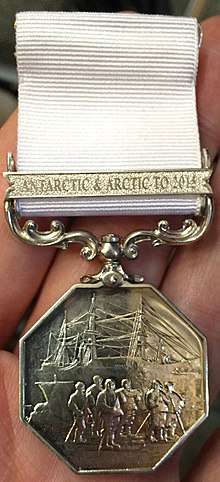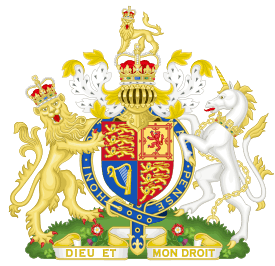Polar Medal
The Polar Medal is a medal awarded by the Sovereign of the United Kingdom. It was instituted in 1857 as the Arctic Medal and renamed the Polar Medal in 1904.
| Polar Medal | |
|---|---|
 | |
| Awarded by United Kingdom | |
| Type | Medal |
| Awarded for | extreme human endeavour against the appalling weather and conditions that exist in the Arctic and Antarctic |
| Statistics | |
| Established | 1857 |
| Order of Wear | |
| Next (higher) | Campaign Medals and Stars[1] |
| Next (lower) | Imperial Service Medal[1] |
Reverse of medal and ribbon | |
History
The first polar award was called the Arctic Medal which was presented twice in the 19th century. The Admiralty issued the medal in 1857 for several expeditions, including the expedition to discover the fate of Sir John Franklin and his crew who were lost while looking for the Northwest Passage in 1847:
Her Majesty having been graciously pleased to signify her commands that a Medal be granted to all persons, of every rank and class, who have been engaged in the several Expeditions to the Arctic Regions, whether of discovery or search, between the years 1818 and 1855, both inclusive.[2]
The second presentation of the Arctic Medal was to the crews of three ships exploring the Arctic in 1875–76.
In 1904, the Polar Medal was inaugurated for members of Captain Scott's first expedition to Antarctica. It was also awarded to the crews of both rescue ships, Terra Nova and Morning. Subsequent medals were also awarded to members of Ernest Shackleton's expeditions in 1907–09 and 1914–17.
Until 1968, the Polar Medal was presented to anyone who participated in a polar expedition endorsed by the governments of any Commonwealth realms. However since then the rules governing its presentation have been revised with greater emphasis placed on personal achievement.
The Medal may be conferred on those citizens of the United Kingdom of Great Britain and Northern Ireland who have personally made conspicuous contributions to the knowledge of Polar regions or who have rendered prolonged service of outstanding quality in support of acquisition of such knowledge and who, in either case, have undergone the hazards and rigours imposed by the Polar environment. The Medal may also be awarded in recognition of individual service of outstanding quality in support of the objectives of Polar expeditions, due account being taken of the difficulties overcome.
A total of 880 silver and 245 bronze medals have been issued for Antarctic expeditions. Another 73 silver medals have been issued for service in the Arctic. In 2016 the medal was awarded to Kim Crosbie for her work in both the Arctic and the Antarctic.[3] Also in 2016, Agnieszka Fryckowska was awarded a Polar Medal at Buckingham Palace.[4]
Several people have been awarded clasps to the medal for earning the award again for polar expeditions. Frank Wild and Ernest Joyce hold the joint record of four clasps on their Polar Medal.[5]
Design
The medal is octagonal in shape with a white ribbon.[6] The reverse of the original Arctic Medal showed a three-masted ship surrounded by ice floes.[6] The die for the medal was engraved by Leonard Charles Wyon. A new design by Ernest Gillick was used from 1904, showing RRS Discovery, with a sledging party in the foreground.[7] The obverse bears a portrait of the reigning monarch.
The medal was originally struck in both silver and bronze. Since 1939, all awarded medals have been silver;[6] bronze medals were presented to personnel on relief ships for Antarctic expeditions, but not awarded to participants of Arctic expeditions.
Australia
The Government of Australia replaced the Polar Medal with its own Australian Antarctic Medal in 1987.[8]
Canada
The medal was awarded to members of the RCMP ship St. Roch, who patrolled extensively in the western Arctic (1940) and completed a west-to-east passage of the Arctic in 1942. Although several Canadians had received this medal,[9] it was not included in the Canadian Honours System that was promulgated in 1967. Subsequently, a Canadian decoration intended to honour explorers of Canada's polar regions and defenders of the country's sovereignty in the north was initially conceived by Governor General Adrienne Clarkson as the Governor General's Northern Medal and created on 15 September 2005, to award those who serve with distinction in northern Canada. It was replaced on 23 June 2015, by Canada's own Polar Medal.
New Zealand
In 1996, when New Zealand revised its royal honours system, New Zealanders ceased to receive the Polar Medal. It was proposed that the medal would be preserved, with a new name, under New Zealand regulations: the New Zealand Antarctic Medal. The rationale for the renaming was that it is in relation to Antarctica that New Zealand's endeavours and achievements have been made. The Report on honours that recommended the change contained the inaccurate claim that the medal was named after the North Pole. The new medal was formally instituted by the Queen on 1 September 2006.[10]
See also
References
- "No. 56878". The London Gazette (Supplement). 17 March 2003. p. 3352.
- "No. 21997". The London Gazette. 5 May 1857. p. 1580.
- "IAATO Executive Director and Falklands' resident awarded the Queen's Polar Medal". en.mercopress.com. Merco Press. 2016. Retrieved 6 August 2016.
- Tanaka, Kisei (30 May 2016). "Five winters on Antarctica: Agnieszka Fryckowska - Antarctic and Southern Ocean Coalition". Antarctic and Southern Ocean Coalition. Archived from the original on 9 September 2017. Retrieved 8 September 2017.
- "Antarctic Medals". Antarctic-circle.org. Retrieved 9 January 2019.
- Mills, William J. (2003). Exploring Polar Frontiers: a Historical Encyclopedia, Volume 1. 1. ABC-CLIO. p. 420. ISBN 978-1-57607-422-0.
- "Polar Medal 1904, George V". The Royal Collection. Retrieved 23 October 2011.
- "Australian Antarctic Medal" (PDF). It's an Honour. Government of Australia. 29 September 2008. Archived from the original (PDF) on 26 August 2016. Retrieved 18 April 2014.
- "POLAR MEDAL" (PDF). Blatherwick.net. 4 February 2016. Retrieved 9 January 2019.
Prepared by Surgeon Captain John Blatherwick, CM, CStJ, OBC, BSc, DPH, MD, FRCP(C), LLD
- "The New Zealand Antarctic Medal". Department of the Prime Minister and Cabinet. Archived from the original on 16 May 2014. Retrieved 18 April 2014.
Bibliography
- Poulsom, Neville W. (1968). The White Ribbon: A Medallic Record of British Polar Expeditions. B.A. Seaby, London. ISBN 0-900652-00-4.
- Poulsom, Neville, W, and Myres, J.A.L., (2000). British Polar Exploration and Research: A Historical and Medallic Record with Biographies, 1818–1999. Savannah Publications, London. ISBN 1 902366 05 0.
